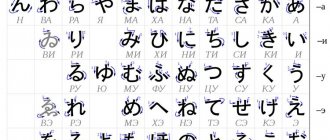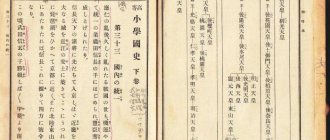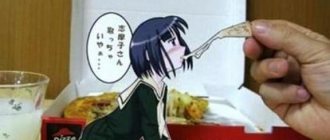This term has other meanings, see Yari.
Yari(Japanese 槍) is a Japanese type of pole weapon, which is a spear and has many modifications. The term appeared during the Kamakura period.
Story
The oldest Japanese spear was the hoko.
.
Hoko tips were socketed, with a rhombic feather about 25 cm long in cross-section. Sometimes they were additionally equipped with a hook, like a hook. The Nara period dates back to the appearance of the teboko
- a “hand spear” with a straight or slightly curved tip of about 30 cm, with a protruding edge.
At first it was distinguished by a small shaft and may have been used for throwing, but by the Nambokucho period its length increased to 1.8 m, and it began to be called kikuchi-yari
. In the second half of the Muromachi period, spears became most widespread and various modifications appeared.
Yari design
In addition to the spear blade, the weapon was often enhanced with additional damaging elements.
The advantage of this type of weapon is reliability. When removed from the enemy’s body, Hoko sometimes got caught in the fastening elements of the sleeve, the tip was disconnected, and the fighter remained unarmed. The answer was the following technical solution - a yari dagger blade (150-900 mm) was inserted with a pin into the end of the shaft, which was additionally varnished along the entire length of the shank, fastened with metal washers, and wrapped with cord. In addition to the spear blade, the weapon was often reinforced with additional damaging elements - a spike-spike (one or two), a sharpened crescent.
Since the goal is to defeat a heavily armed warrior at a long distance, the heavy weight did not imply the flexibility of the product (unlike its Chinese counterparts). Similar to the mainland design was the frequent placement of bows, ponytails, and ribbons at the tip. This was done so that the enemy’s blood was absorbed, preventing the hands from slipping, and also to distract the enemy’s attention.
The warrior held the yari with both hands, directed with his left, struck with his right (the injections were performed similarly to the technique of playing with a cue on billiards), sliding was achieved using a guide sleeve. The guard served as additional support/protection for the hands.
For protection from moisture and safety on the march, all spears were equipped with fabric covers and varnished scabbards with the clan coat of arms printed on them. The counterweight at the opposite end was made of metal; it could be used to deliver sudden thrusts.
Design
The classic yari consists of a shaft ( ebu
or
nagae
), to which the tip (
ho
) is attached.
The shaft is 1.8-2.5 m long, in cross-section, as a rule, round or multifaceted (rather than oval), made of oak or, less commonly, bamboo. The tips were 15–90 cm long and had a sword-shaped shape; they were fastened with a shank ( nakago
).
They allowed piercing and slashing blows. Thanks to such tips, yari can be classified as glaives. hadome
cross was made 30 cm below the tip .
The usual one was tsuba. For more reliable fastening, the end of the shaft was equipped with a fastening coupling ( habaki
) and washers (
seppa
).
At the lower end there was an undercurrent ( ishizuki
), which could be used for striking.
The upper part of the shaft was varnished and wrapped with cord ( sen-dan-maki
).
Description[edit]
Omi yari (large spear), Tokyo National Museum.
Yari were characterized by a straight blade that could range in length from a few centimeters to 3 feet or more. [3] The blades were made from the same steel ( tamahagane
), from which traditional Japanese swords and arrowheads were forged, and were very durable.
[3] Many variations of the straight yari blade have been produced throughout history, often with ridges on the central blade. Yari blades often had a very long tail ( nakago
);
this will usually be longer than the pointed part of the blade. The tang protruded into the reinforced hollow part of the handle ( tachiuchi or tachiuke).
), which results in a very rigid shaft, making it almost impossible for the blade to fall or break. [3]
Shaft ( nagaye or ebu
) were of different lengths, widths and shapes;
Made of hardwood and covered with varnished bamboo strips, they were oval, round or polygonal in cross-section. These in turn were often wrapped in metal rings or wire ( dogane
) and attached with a metal pommel (
ishizuki
) at the end.
Yari shafts were often decorated with inlays of metal or semi-precious materials such as brass pins, lacquer, or pearl flakes. The scabbard ( saya
) was also part of the full yari. [3]
Varieties
Su-yari
Also sugu-yari
. Simple spears with a straight tip. The tip shape included:
- Sankaku-yari
- with a triangular feather. - Ryo-sinogi-yari
- with a feather of a rhombic section. - Sasaho-yari
- with a feather in the form of a bamboo leaf.
Along the length of the shaft:
- Omi-yari
are exceptionally long yari. Sometimes they reached 6.5 m in length. Such spears were used only against cavalry. - Te-yari
- shortened spears for indoor combat. Total length 2.1 m, 15 cm tip.
Fukuro-yari is also distinguished
with sleeve tip.
Kama-yari
Means "spear-sickle". They had additional blades.
- Jumonji-yari
or
Magari-yari
is a Japanese runka.
She had two additional ed
that were slightly curved forward. - Katakama-yari
- this weapon was distinguished by one additional blade or asymmetrical additional blades. - Sitamuko-kama-yari
and
sitamuko-jumonji-yari
are yari with rear-facing side blades. - Kagi-yari
differed from ordinary yari only in the presence of a forward-facing hook attached to the base of the tip for capturing enemy weapons. - Bishamon-yari
is a kind of halberd with two axes with concave blades.
Yari shaft options[edit]
The yari shaft can range in length from one meter to six meters (3.3 to 20 feet).
- Nagae yari
(long-shafted spear) 16.4 to 19.7 feet (5.0 to 6.0 m) long, a type of pike used by ashigaru. [14] [15] It was especially used by the ashigaru of the Oda clan since the reign of Oda Nobunaga; Samurai tradition of the time held that the soldiers of the rural province of Owari were among the weakest in Japan. Indeed, Kanto was a place of chaos; Kansai was home to the shogunate and the Uesugi, Takeda, Imagawa and Hojo clans, as well as pirate raiders from Shikoku. Additionally, Kyushu was home to one of Japan's most warlike clans, the Shimazu clan. Because of this, Nobunaga armed his ineffective Ashigaru soldiers with extra-long pikes to make them more effective against armored opponents and cavalry, and to fight in groups and formations. - Mochi yari
(hand spear), a long spear used by ashigaru and samurai. [16] - Kuda yari
(管槍, tubular spear).
The shaft passes through a hollow metal tube, which allowed the spear to be twisted during a thrust. This style of sojutsu is represented in the Owari Kan Ryu
. - Makura Yari
(spear pillow). A yari with a short, simple top that was kept by the bed for protection at home. [17] - Te yari
(hand spear). A short-shafted yari that was used by the samurai police to catch criminals. [18]
see also
- Rohin - Okinawan spear
- A spear
- Glaive
- Rohatina
| Long swords | Chokuto · Dotanuki · Katana · Shin-gunto · Tachi · Tsurugi · Uchigatana |
| Short swords | Chizakatana · Kodachi · Shikomizue · Wakizashi · Ninjato |
| Knives/daggers | Aikuchi · Hachiwara · Tanto · Kaiken · Yoroi toshi · Kusungobu |
| Training weapon | Bokken · Iaito · Shinai · Suburito · Tanren bo |
| Fictional swords | Daikatana · Zambato |
| Other | Nagamaki · Naginata · Bisento |
Excerpt characterizing Yari (weapon)
Alpatych, having arrived in Smolensk on the evening of August 4th, stopped across the Dnieper, in the Gachensky suburb, at an inn, with the janitor Ferapontov, with whom he had been in the habit of staying for thirty years. Ferapontov, twelve years ago, with the light hand of Alpatych, having bought a grove from the prince, began trading and now had a house, an inn and a flour shop in the province. Ferapontov was a fat, black, red-haired forty-year-old man, with thick lips, a thick bumpy nose, the same bumps over his black, frowning eyebrows and a thick belly. Ferapontov, in a waistcoat and a cotton shirt, stood at a bench overlooking the street. Seeing Alpatych, he approached him. - Welcome, Yakov Alpatych. The people are from the city, and you are going to the city,” said the owner. - So, from the city? - said Alpatych. “And I say, people are stupid.” Everyone is afraid of the Frenchman. - Women's talk, women's talk! - said Alpatych. - That’s how I judge, Yakov Alpatych. I say there is an order that they won’t let him in, which means it’s true. And the men are asking for three rubles per cart - there is no cross on them! Yakov Alpatych listened inattentively. He demanded a samovar and hay for the horses and, having drunk tea, went to bed. All night long, troops moved past the inn on the street. The next day Alpatych put on a camisole, which he wore only in the city, and went about his business. The morning was sunny, and from eight o'clock it was already hot. An expensive day for harvesting grain, as Alpatych thought. Shots were heard outside the city from early morning. From eight o'clock the rifle shots were joined by cannon fire. There were a lot of people on the streets, hurrying somewhere, a lot of soldiers, but just as always, cab drivers were driving, merchants were standing at the shops and services were going on in the churches. Alpatych went to the shops, to public places, to the post office and to the governor. In public places, in shops, at the post office, everyone was talking about the army, about the enemy who had already attacked the city; everyone asked each other what to do, and everyone tried to calm each other down. At the governor's house, Alpatych found a large number of people, Cossacks and a road carriage that belonged to the governor. On the porch, Yakov Alpatych met two noblemen, one of whom he knew. A nobleman he knew, a former police officer, spoke heatedly. “It’s not a joke,” he said. - Okay, who is alone? One head and poor - so alone, otherwise there are thirteen people in the family, and all the property... They brought everyone to disappear, what kind of bosses are they after that? . - What do I care, let him hear! Well, we are not dogs,” said the former police officer and, looking back, he saw Alpatych. - And, Yakov Alpatych, why are you there? “By order of his Excellency, to Mr. Governor,” answered Alpatych, proudly raising his head and putting his hand in his bosom, which he always did when he mentioned the prince... “They deigned to order to inquire about the state of affairs,” he said. “Well, just find out,” shouted the landowner, “they brought it to me, no cart, no nothing!.. Here she is, do you hear? - he said, pointing to the side where the shots were heard.
Yari
One of the places of honor in the samurai's arsenal is the spear . It even became one of the symbols of this class.
The end of the Heian era - the beginning of the Kamakura period was the time of the naginata . She was the polearm leader. But it was then that the first examples of spears appeared - yari , which became classics over time.
In the course of the evolution of yari, all kinds of tips were created, but the most ancient and classic is considered to be the simple straight double-edged suyari tip, 15 to 90 cm long. The tip was attached to an oak, sometimes bamboo, shaft 180-250 cm long using a shank. The shaft along the length of the shank was wrapped in several layers of rope and supplied with isizuka inflow and semegane rings.
in the ancestry of the Yari , but no matter what is said, today it is without a doubt clear that the Yari and the fighting technique were influenced by China.
The Nambokucho period (1333 – 1391) was a very turbulent period in Japanese history. The whole country was engulfed in bloody battles. This is a time of great changes in the military art of Nippon. From this period, the bushi army included numerous detachments of ordinary infantrymen from the “serfs”. Battles turn into collective actions of the prevailing masses of poorly trained infantry units, which became the main reason for the spread of the yari spear . Yesterday's villager was powerless in front of a professional samurai, who had been studying fighting techniques since childhood. But the stockade of spears deployed in battle quickly turned any pro into a colander or forced him to retreat. And mastering the basic technique of spear combat is much faster than learning the basics of handling a sword or halberd. And this is very noticeable when training a large crowd of recruits.
This curious fact is noted in the history of Japan. It was during this period that many Japanese heroes became famous. It is known from the chronicles that these heroes, due to their incredible strength, preferred huge swords or halberds, and some preferred konsaibo - a heavy stake bound in iron. It was against such miracle warriors that a spear, which was longer than any type of weapon, came to the rescue.
The first half of the Muromachi era was quite calm. During this period, the yari remained mainly the weapon of ordinary soldiers, already as their standard weapon. The yari of this period were ordinary spears without any additions.
After the turmoil of the Onin years (1467-1477), the “ennoblement” of Yari begins. More and more high-ranking bushi are using yari as their weapons. Almost all daimyo create special units of spearmen operating as a phalanx. Yari appear with super-long shafts. In the Oda clan they reached 650 cm.
Since the era of Azuchi-Momoyama (1573-1599), yari has won the love of an increasing number of military leaders and ordinary samurai. During this period, masters of sojutsu (spear art) create a new spear - kagiyari . This is a spear with a long straight tip, with a winding around it to prevent blood from flowing onto the shaft and an L-shaped or U-shaped crossbar behind it.
The most interesting innovation of this period was the kudayari - “spear with a pipe.” It was equipped with a tube handle with a guard. By moving the shaft in this tube it was possible to carry out sudden and quick injections.
Who invented this weapon today cannot be determined. But some sources from the early Tokugawa period suggest that this question is irrelevant. For the use of a spear with a pipe was a common thing for spearmen with a crippled hand - a common wound of war. In “Yagi Zuihitsu” it is written like this: “... The creator of this spear, kudayari , which is now so extolled, was a master of fighting with a simple spear, but when the thumb of his left hand was cut off, he could no longer use suyari and therefore began to tie a pipe to his wrist. And his students forgot that all their fingers were in place, and they also began to use tubes and now make the excuse that they do it to speed up the injections. So it turns out that what is now revered as a wonderful art actually goes back to the pipe that the spearman used in a desperate situation. I am writing about this not to talk about the effectiveness of this art, but to point out the loss of the original essence of spear art. When we hear of someone using a spear with a pipe without knowing the principle, we should feel angry. If a proper understanding of the principles of spear art is achieved, the pipe will be destroyed.”
During the Azuchi-Momoyama era, yari became widely used among bushi, and many schools of sojutsu . It is not for nothing that this era is considered the era of the spear.
After the fall of the shogunate, sojutsu, like other martial arts, became an unnecessary relic of the past. For some time, the practice of spear combat was practically interrupted. But it didn't last long. In the late 70s of the 19th century, the Kokusui ideology began to spread, emphasizing the national characteristics of the Japanese and Japan. Favorable ground began to emerge for the revival of martial arts.
After the end of World War II, very few ancient schools of sojutsu remained. They are a valuable cultural property of Japan.
| Have you read it? Liked? You can also: Add to favorites |
| Stock! Discounts! Competitions! Discount on Bestblades from Haralug Friends! We all love FREE! Well, if not all, then many. Our chief is Harm - that’s for sure! And he loves it, and he loves to give it, this very FREE. Today's freebie... Comments (0) | |









